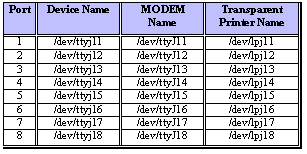|
APPENDIX C XENIX/UNIX CONFIGURATION The distribution disk contains SCO, AT&T, UNIXWARE, and INTERACTIVE UNIX/XENIX driver, it detects non-FIFO or FIFO chips automatically. Our drivers also provide transparent printer features that let user to connect local printer from auxiliary port of terminal. The hardware configuration and software installation procedures are shown is the bellows. C.1 Suggested Hardware Configuration 1.
First adapter
I/O port address: 280H Interrupt level: IRQ4 Interrupt vector: 2C0H  
2.
Second Adapter
I/O port address: 240H
Interrupt level: IRQ3 Interrupt vector: 2D0H
|
||||||||||||||||||||
C.2 Software
Installation
The installation procedure for the device drivers is described as
follows:
#cd / # doscp d:dc.tz ./dc.tar.Z ["dosget" in Interactive UNIX] # zcat dc.tar / tar xvfp -
#cd /usr/sys/pccom/dc
# ./install
# entty ttyj11
# entty ttyj12
.
. For SCO UNIX & XENIX by using
enable command.
NOTE:
:unix.old
a. login as a root
user
b. # cd /usr/sys/pccom/dc c. Remove PCCOM Driver from the kernel #./ remove
#distty ttyj11
|
||||||||||||||||||||
|
|
||||||||||||||||||||
|
C.4 Transparent Printer By multiplexing a serial line, there are two sorts of data channels for TTY data(by /dev/ttyXYY) and TP data(by /dev/lpXYY). If the /dev/ttyj11 is used for a TTY, it has to be enabled before you would like to print data through /dev/lpj11 to a printer that connected to the terminal that is operated via /dev/ttyj11. The channel for TP data that is uni-directional is used to transmit the data from a host to a terminal only. The differentiates of TTY data and TP data in the same serial line is that TP data are encapsulated within a couple of PRINT-ON and PRINT-OFF escape strings that are recognized by connected terminals. The PRINT-ON and PRINT-OFF is defined by connected terminals. The scheme to multiplex a serial line for these two channels is based on time-division method. The time slices for TTY or TP data are generated according to the entry procedure, polling, in the PCCOM driver, which is periodically called by system clock. The period of system clocks is different among various operating systems, e.g. most UNIXs is 100hz, but SCO Xenix is 50hz. The interval reserved for TTY or TP channel in the same serial line is important to output TP data to a low-speed printer through high-throughput line from PCCOM cards if there is no flow control XON/XOFF to the serial line. The lpx command is used to adjust the time interval for TTY or TP data and the TP protocol. lpx [option] device
name
-t number: set interval for TTY
-l number: set interval for Transparent Printer -n string: set esc string to turn on printer -f string: set esc string to turn off printer -T : get interval for TTY -L : get interval for Transparent Printer -N : get esc_string to turn on printer -F : get esc_string to turn off printer
The range of interval reserved for TTY or TP channel is from 1 to maximum integer. The default setting for any /dev/lpXYY is as follows: Interval for TTY : 50
Interval for TP : 1 PRINT - ON escape : ¡§\033[5i¡¨ (ESC[5i) PRINT ¡V OFF escape : ¡§\033[4i¡¨ (ECS[4i)
# lpx -t 60
/dev/ttyj11
# lpx 12 /dev/lpj11
# lpx L /dev/lpj11
# lpx n \033[51
/dev/lpj11
# lpx F /dev/lpj11
\033[4i
|




